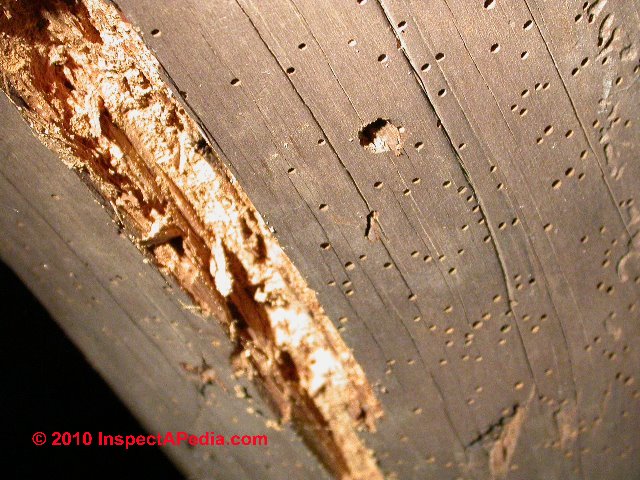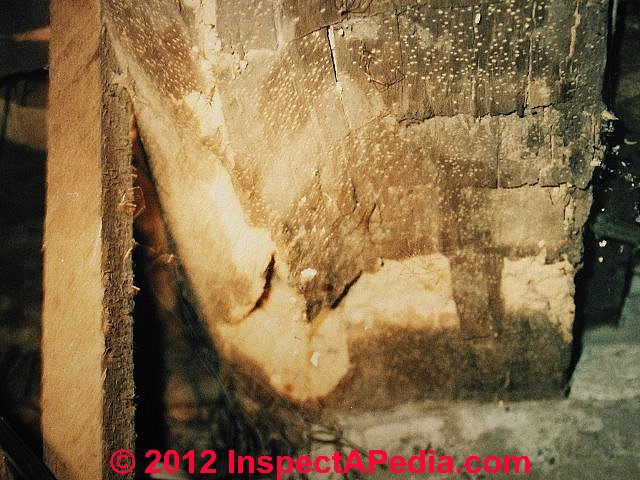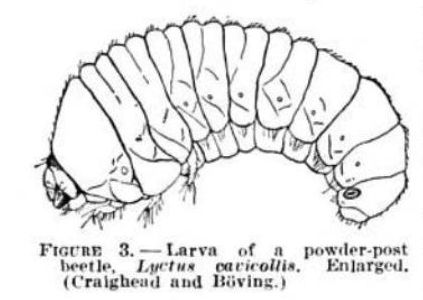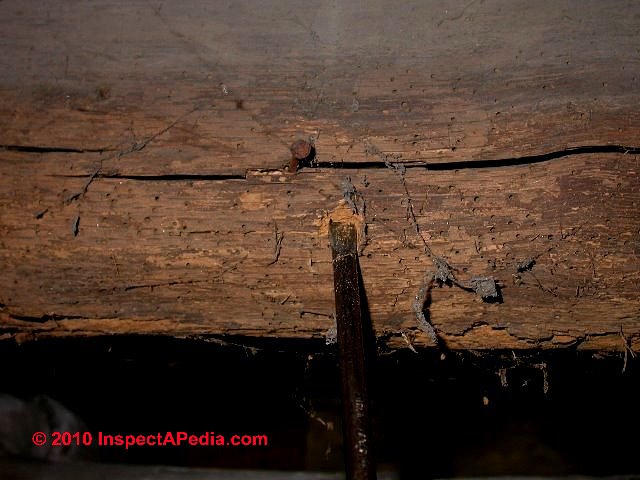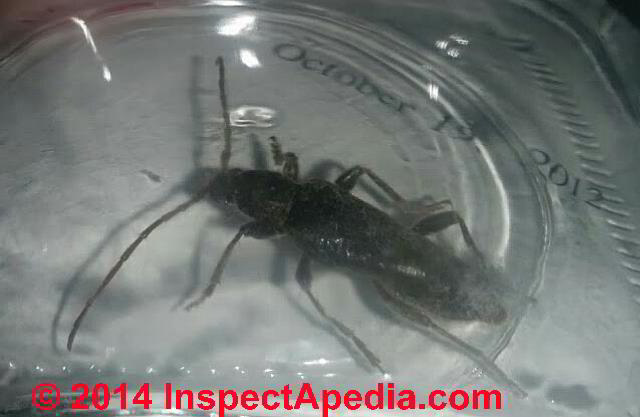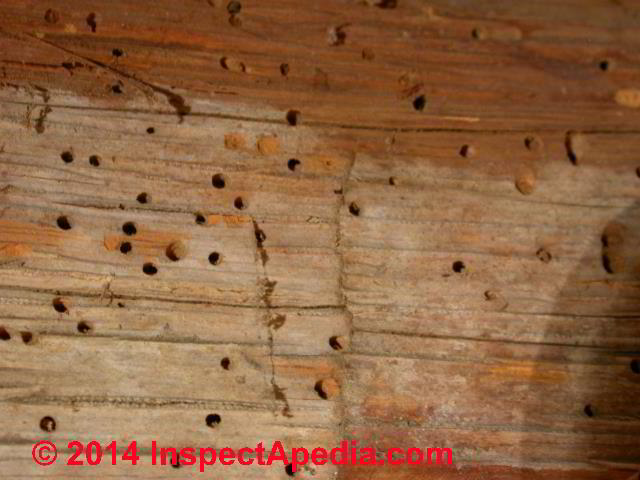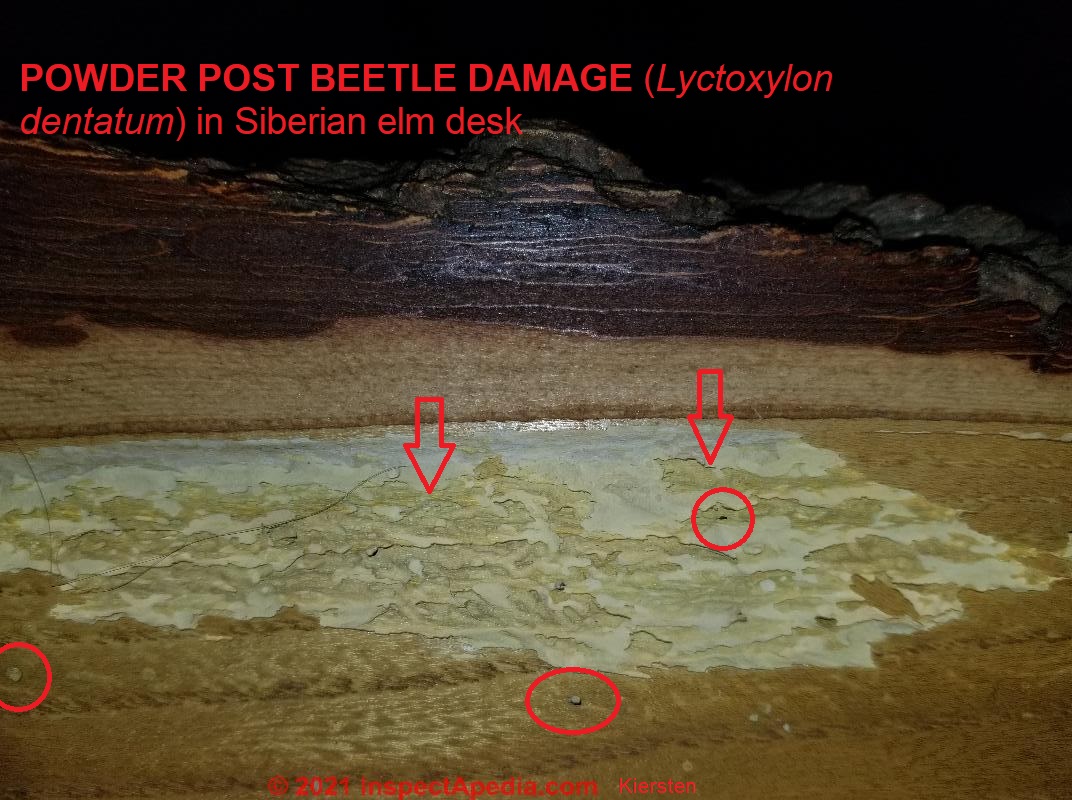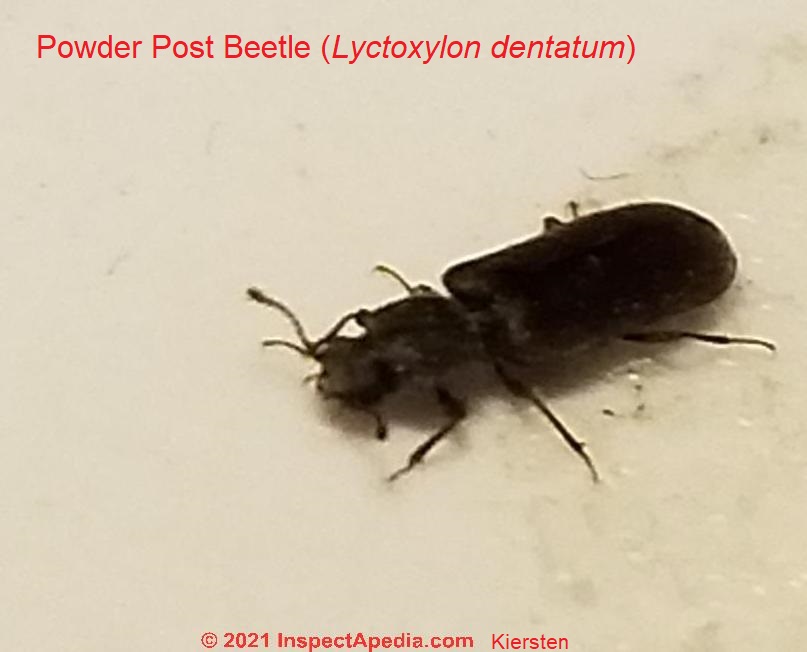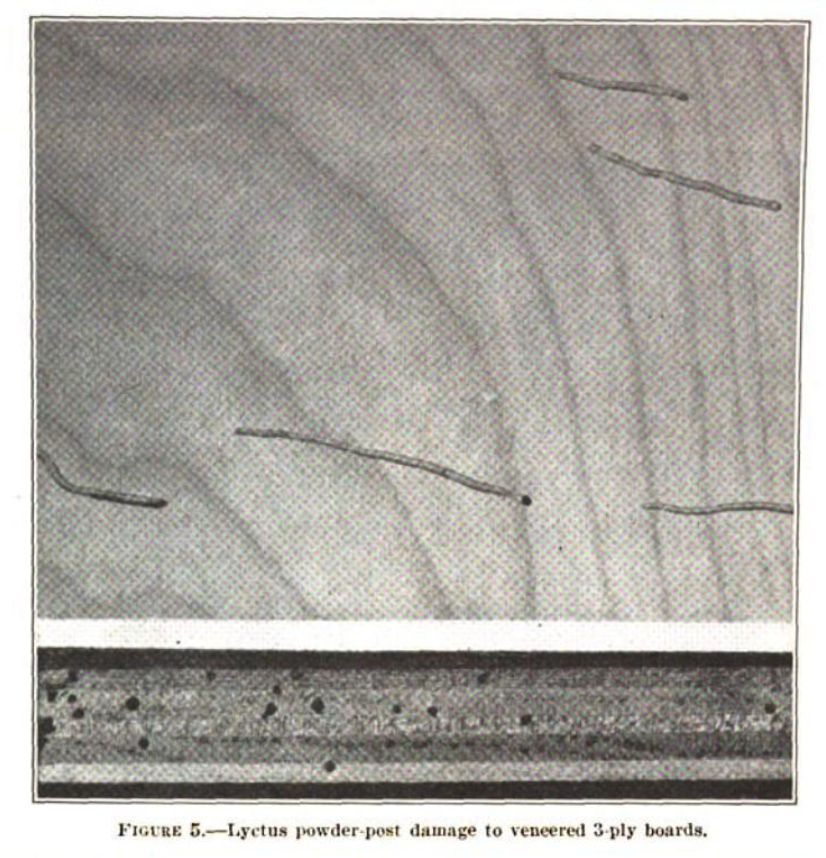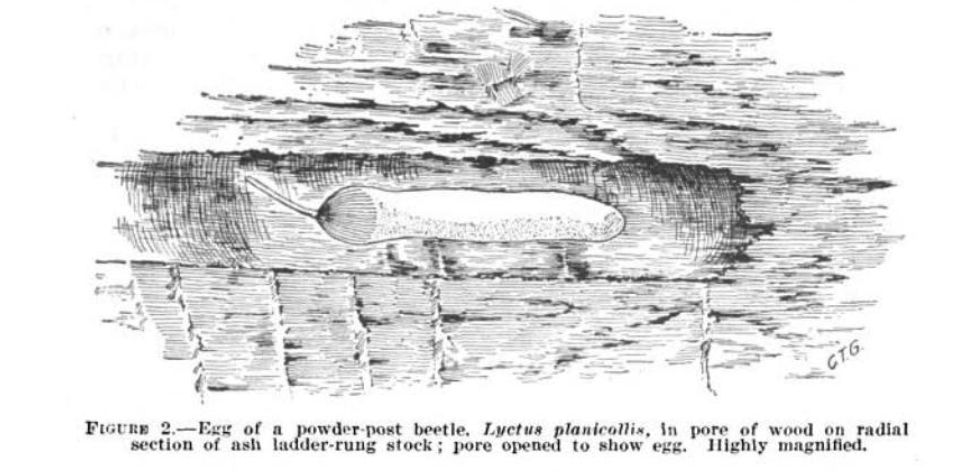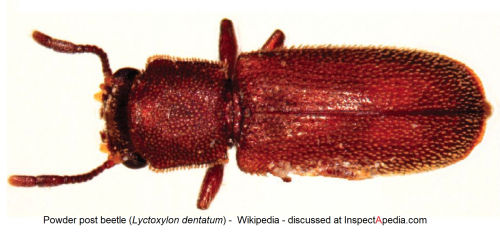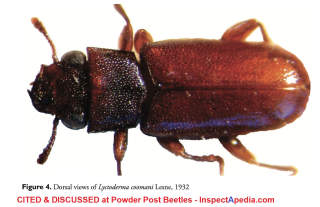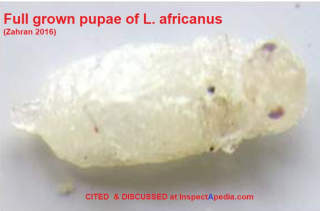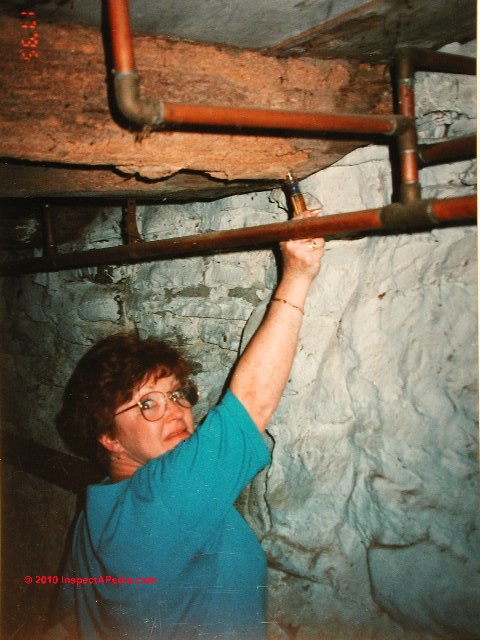 Evaluate & Prevent Powder Post Beetles & Old House Borer Structural Damage
Evaluate & Prevent Powder Post Beetles & Old House Borer Structural Damage
+ treatment of wood furniture for powder post beetles
- POST a QUESTION or COMMENT about powder post beetle damage at buildings: how to recognize & assess powder post damage to wood structures
Guide to powder post beetles & old house borers in buildings.
This article provides powder post beetle & old house borer insect & rot damage photographs, inspection advice, and lists additional articles that discuss the inspection, detection, prevention, and repair of structural damage from insects (termites, carpenter ants, carpenter bees, powder post beetles, and other wood destroying insects), indoor mold, rot and building leaks or water entry.
Our page top photo shows our client holding a screwdriver that penetrated a powder-post-beetle-damaged beam fully to the hilt of the tool - indicating severe structural damage to a beam damaged by powder post beetles.
InspectAPedia tolerates no conflicts of interest. We have no relationship with advertisers, products, or services discussed at this website.
- Daniel Friedman, Publisher/Editor/Author - See WHO ARE WE?
Powder Post Beetles - Old House Borer Damage Photographs
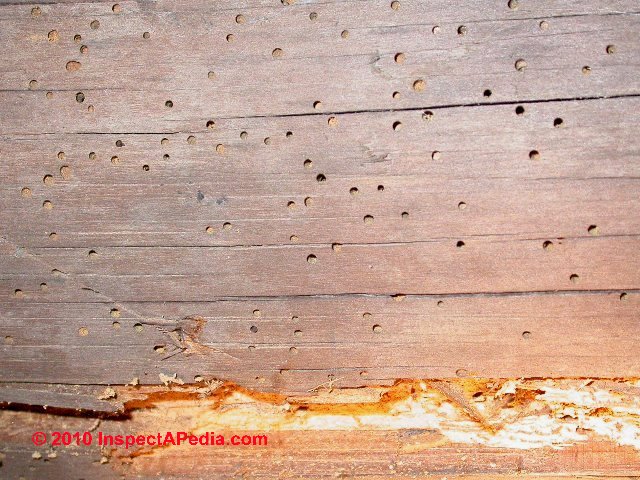
In our powder post beetle photos above, while there was significant beam damage, the infestation did not appear active.
Powder post beetle damaged wood will show multiple tiny holes, about 1/8" in diameter, leaving the outermost surface of the wood otherwise intact. Attacks on wood structures or furniture by this insect are notoriously difficult to treat and they've been the subject of worldwide study for more than 100 years (Hopkins 1903), with growing attention following the second World War.
Since the year 2000 L. brunneus is gradually being replaced by L. cavicollis. Other species of the subfamily Lyctinae are rarely found.
In the past L. brunneus was a typical indoor pest in Central Europe which was brought into new buildings with infested wooden materials or furniture. ( Pospischil 2017)
Probing you will find powdery sawdust and damaged wood just below this skin. The older the powder post beetle (or old house borer beetle) damage is, the deeper into the wood the damage will extend.
For this reason, strategic probing is important to assess the depth of damage to the wood and thus to the wood structure. When powder post beetles are active you may see light dusting of fine wood powder around some of these holes as well as on surfaces below.
We look for the presence of fine wood powder around the insect exit holes or on the ground below the damaged infected member as indications of recent insect activity.
Below we are probing to determine the depth of insect damage into the beam;
and in the next photo below you can see powder post beetle damage in a hand hewn beam.
With the absence of fresh fine sawdust powder around the exit holes in these beams one might infer that the insects were not active at the time of inspection.
Below: a sketch of a powder post beetle larva (Snyder 1938) cited below in this article.
Below are more photographs of old house borer or powder post beetle damage in a floor support beam. We probe the structural member to find the depth of insect damage as a step in deciding if structural repair, reinforcement, or replacement are needed.
How to assess the extent of structural damage from powder post beetles
Details about when, where, how & why to probe wood structural and nonstructural components on buildings are found
Assessing the extent of structural damage to wood framing members in a conventional building inspection involves the following phases and procedures:
Examples of probing powder post beetle infested wood for structural damage
Shown below, the ground-off ice pick wood probe s finding less-severe damage than the "to the hilt" stab of my dad's screwdriver demonstrated by our client above.

Watch out: while we advise against unwarranted cosmetic damage at a building interior, strategic probing of wood sills, rim joists, or floor structures (or other wood members) can disclose severe structural damage that was otherwise not evident.
Below, even our pen was able to easily puncture this termite-damaged joist that had been "cosmetically-repaired" using wood putty
Old House Borer Beetle risk from firewood?
Reader question: old house borers, adult beetles & larvae found in firewood stored in garage
We recently discovered the emergence of hundreds of, what looks like, Old House Borers from firewood that was stacked in our garage.
We've taken the firewood out of the garage now (where we could hear the larvae feeding) but are wondering if there's a possibility that they've infected the house as we have seen dozens crawling around the garage and have found a couple of adult/baby ones in other rooms of the house.
I've attached a picture of the beetle. Any feedback would be very greatly appreciated. - D.D. 6/4/2014
Reply:
Indeed the beetle in your photo looks like an adult old house borer beetle (Hylotrupes bajulus) -
Removing the infected firewood was a smart move. I would not be too nervous about seeing a few beetles or larvae that needed to be cleaned up on a garage floor.
IF the firewood were stored for many months against wood framing, indeed that framing could become infected too - you'd expect to see the small borer openings such as those we show in the article above.
If you see such infection (which is unlikely given the history you cite) send me some photos and I can comment further and of course a local pest control operator can apply a topical pesticide.
At above left I include a close-up photo of old house borer beetle exit holes - these are typically around 1/16"+ in diameter.
If the home has an accessible basement or crawl area that's the place to start inspecting with care.
Treatments for Powder Post Beetles & Old House Borers
 Powder post beetle damage is typically treated with a topical insecticide spray.
Powder post beetle damage is typically treated with a topical insecticide spray.
Where infestation is severe and active, a tenting and fumgiation procedure (typically using Vikane) can be effective at killing both adult and larval powder post beetles. More on powder post beetle treatment by fumigation is below on this page.
Watch out: it's often the case that this insect pest can appear dormant for a very long time, years, but activity may renew when conditions such as moisture level or temperature change.
Some pest control operators (PCOs) also spray paint the wood surfaces in order to make it easier to spot a renewal of insect activity in the future.
An anonymous reader posted a claim that powder post beetles can be treated by microwave - the comment was deleted as it was basically an advertisement.
However experiments with microwave treatments for powder post beetles have indeed been conducted: wood is heated to 50C (or higher) for 30 minutes.
Watch out: the effectiveness of this treatment varies depending on wood species, moisture content, and other variables, and it may not be cost feasible for some structures or where invasion is extensive.
The research is focused on lab and production line treatment of wood, not in-situ treatment in buildings. Excerpting from Fleming et als
Wood temperatures greater than 62°C are lethal to pinewood nematodes and cerambycid larvae infesting red pine in a chamber in which the wood samples remain stationary.
Our preliminary findings also suggest, however, that nematodes or larvae in lumber in which the mw field is continuously moving, either by rotation or on a conveyor belt, die at lower wood temperatures than in a batch system without movement.
We recommend that additional experiments with non-stationary, commercial equipment be conducted to investigate this phenomenon further.
Additional assessment of the effects of conventionally heated vs non-heated mw chambers on lethal mw doses would also be helpful for the commercialization and regulatory process.
We can conclude from our experiments that commercial mw treatment (2.45 GHz) of 1-inch thick red pine lumber infested with cerambycids or pinewood nematodes is a feasible alternative to conventional heat treatment or methyl bromide fumigation. - Fleming (2005)
Powder post beetle (Lyctoxylon dentatum) infesting a Siberian elm desk: 12 Treatment Options
I have a desk made of pine and Siberian elm with some wood borer infestation. The bugs/beetles are small, brown, narrow and seem to have several legs on both sides.
Attached is a picture of the damage just under the surface of the elm that came away.
I would appreciate any help. I have not (as of yet) kept one to take a photo of.
Thank you. - 2021/03/30 - Kiersten
Moderator reply:
@Kiersten, sorry but from just your photo I cannot identify the word damaging insect. If you see what looks like mud or mud tubes that you probably have termites. Of course it could be something else. Try taking one of your insect to your local farm at home or environmental center. Or post a photo here for identification.
It's unusual to see surface damage and exposed insect galleries in the summer wood of the furniture like that in your photo. Usually all that we see of powder post beetles damage or a small holes in the surface of the wood.
It'd be useful to see a sharp photo of your powder post beetle as they're usually pretty shy about having their picture taken.
Reader follow-up:
I found one and it's a powder post beetle.
Moderator Reply: treatment & prevention of powder post beetle damage to wood furniture
In a less-common case I studied in Newburgh, New York decades ago, in a home that was virtually entirely eaten and destroyed by termites we found termite infestion in the legs of tables and chairs that had not been moved in years; termites entered the furniture by tunneling up through a wood floor into the furniture legs.
But in furniture that is more-often moved about, I suspect that at least sometimes the insect damage such as your powder post beetle infestation of a wooden desk is caused by larvae or eggs that were present in the wood at the time that the furniture was actually constructed.
Powder post beetles are difficult to treat effectively as their larvae can be deep inside the wood where they may survive for more than a decade (Lippert 1994).
Are Your Powder Post Beetles Active?
Above: tunnels of old powder post beetle activity in lumber that was sliced into plies in the constrution of plywood. (Snyder 1938).
Building owners/occupants can spot new powder post beetle activity by noticing very fine fresh light-yellow or pale yellow coloured sawdust around the small exit holes in wood. Other experts describe active powder post beetle frass as "light and fluffy" or as a "flour-liek powder" found on or piled beneath the infested wood. (Snyder 1938)
Old beetle frass will be darker in coluring, often a brassy colour or even brown, and it is usually more-adhered to the wood surface, having bonded, perhaps, by cycles of moisture or even by a prior pesticide application.
Twelve Beetle-damaged furniture treatment options
Below: powder post beetle larvae may be deep within wood where they're not much bothered by surface-applied pesticides. (Snyder 1938)
In buildings pest control workers often apply a topical pesticide at intervals;
But for treating beetle-infected furniture some different measures may be more successful.
Watch out: before choosing any wood-destroying insect control chemical be sure to review the safe-use procedures necessary; some pesticides are dangerous and can only be applied by a licensed professional.
At REFERENCES FOR CONTROL OF POWDER POST BEETLES / WOOD BORERS you'll find research artilces and more details about these methods for treating powder post beetles in furniture (as well as in wood structures).
- Dry out vulnerable or beetle-infected wood:
keeping moisture levels in wood framing or furniture below 18% helps wood resist attack from powder post beetles, termites, carpenter ants, and various fungi or molds.
Really? Well yes, but drying out wood, while it may retard powder post beetle development, won't reliably kill off insects that have already infested the wood. Because eggs can sometimes survive for more than a decade, should conditions become more moist in the future, powder post beetle activity may well resume.
To pursue this strategy see
BASEMENT WATERPROOFING
and
CRAWL SPACE DRYOUT - Freezing to kill powder post or furniture beetles:
if your powder post beetle or furniture beetle-infested furniture is located in a cold climate such as northern Minnesota, you may be able to kill the insects entirely if you can keep the furniture very cold (10° - 15°F for 72 hours or longer). As recently we were living in -24°F in Two Harbors for several months, when weather is dry and that cold, such treatment is entirely plausible.
A few cycles of freezing, warming, and re-freezing can increase the effectiveness of this approach. (Lippert 1994). - Fumigation to kill furniture beetles:
fumigation (in most cases, by licensed PCO only) in an enclosed chamber or plastic is an option for furniture, and has also been used for entire buildings by "tenting" the building.
Where it can be applied safely, fumigation can effectively kill insects even deeper into the wood than can surface sprays or coatings, but keep in mind that fumigation provides no residual protection against re-infection. (Jones 2008)
Watch out: some chemicals such as methyl bromide discussed in older powder post beetle control articles are now considered unsafe and should not be used.
See details about using sulfuril fluoride (Vikane)
at POWDER POST BEETLE FUMIGATION TREATMENT
- Gamma radiation of furniture:
Though this method had been found effective (Zahran 2016) it does not have practical application for household furniture except possibly in treatment of valuable, historic artifacts (OPINION of the editor). - Heat to kill powder post beetles
was described by Snyder (1923) and of course others; for small items, treatment by microwave may also work. - Immersion in pesticide to kill powder post beetles:
may be feasible for small wood items that can be immersed in a borate solution. (AmOR-S®, Boracane®, Safbor®, TIM-BOR®, or equivalent) - Plant extract treatments kill powder post beetle:
using lemon grass and lantana plants has been reported somewhat successful and may bode well for safe treatments of powder post beetles. (Batt 2013) - Presure injection of pesticides:
into wood using wicks inserted into the bore-holes left by beetles (in most cases, by licensed PCO only) - Removal of the infested wood:
is an option in cases of building structural repair and may also be an option for some furniture. - Steaming
of infected wood has been tested and found not effective against the Aobium sp. powder post beetle in bamboo (Febrianto (2013) though it was more-effective against some termite species. - Surface or topical application of pesticides:
using a spray or brush-applied pesticide (in most cases, by licensed PCO only) is a very common treatment method in houses such as where active powder post beetle infestation is found in wood beams or joists over a basement or crrawl area; for furniture borates can also be applied as a brushed-on slurry or even a thicker paste.
Our OPIION is that surface treatments for wood damaging insects that are often deep within the wood is slow and incomplete in effect. Also in our experience surface treatments of insect-infected wood are limited in penetration and thus effectieness.
Copper-based pesticides penetrate only the first 1/8" or so of wood, depending on wood species and porosity.
Surface coating of insect infected wood with a boron-based insecticide will be ineffective if the wood is furniture whose surfaces are already sealed by paint or varnish. - Seal the surface of furniture:
where you think treatment has been successful, or where wood furniture is not already infested by powder post or furniture beetles, seal all surfaces with a varnish or lacquer. This will reduce the chances of a future infestation from outside the furniture itself.
I [DF] have applied this strategy in the application of clear sealants to the otherwise un-coated wood surfaces of furniture such as the interior and under-side of desks and bureaus and their drawers or pull-outs. I use a spray shellac for a clear, fast-drying method of coating irregular surfaces, applied outdoors in good weather, and with the application of two or three coats.
In homes where powder post beetles have already infected wooden beams, joists, posts, and where those have been treated, some owners paint a sealant on the framing both as a preventative measure and also because that coating makes it easy to spot new, fresh frass indicating a new cycle of insect activity.
Also see our notes about probing wood to determine the extent of damage, discussed above on this page.
Watch out: however experts warn that if there are already eggs, pupa, or adult insects in the furniture, surface sealants won't stop their future emergence and damage.
Reader follow-up:
I am thinking about calling a pest control control company to treat the wood and keep it wrapped in plastic for a couple of months outside after I sand off the varnish.
The desk top is more than 2 inches thick in places.
I live in Colorado. 2021/04/04
Fumigation Treatment of Powder Post Beetle-Infested Furniture
I would be cautious about leaving Furniture outside if it's in a climate that could be humid or wet. If it's so cold where you are that you could freeze at that would be an effective treatment but you wouldn't need more than a few days.
Currently weather in Colorado is mostly well above freezing - so that option's not going to help you before next year.
You could enclose and fumigate the furniture and let it cure under fumigation, but I expect your PCO expert to say that a few days is enough - you don't need months.
A common structural fumigant - applied by a licensed PCO - is Vikane or equivalent. But your PCO may have other suggestions when it's just a bit of furniture being treated for powder post beetles.
Before trying a local wrap-and-fumigate treatment for your powder post beetles, ask your pest control company if they have a local fumigation chamber in which they can treat your table. That would probably be a better, safer, more-effective option and it'll avoid the risk of leaving furniture un-attended outdoors.
Finally: compare the cost of treatment with the value of the furniture being treated.
See this
- VIKANE FUMIGATION PLANNING GUIDE [PDF] from Douglas Products, Vikane, Liberty, MO, USA, Website: https://vikanefumigant.com/ Email: info@douglasproducts.com Tel: +1 800-223-3684 retrieved 2021/04/05 original source: vikanefumigant.com/wp-content/uploads/2017/09/PDF_FumigationPlanningGuide-1.pdf
This is a building fumigation guide but contains information helpful for furniture treatment too.
References for Control of Powder Post Beetles / Wood Borers
Research on treating powder post beetle (Lyctid Beetle) or furniture beetle (Anobid Beetle) infestation in wood furniture and in structures and insecticides and application instructions from agencies such as the US EPA are listed here.
Also for another identification photo, below the image of a powder post beetle (Lyctoxylon dentatum) is courtesy of Wikipedia.
- At POWDER POST BEETLE / FURNITURE BEETLE TREATMENT in FURNITURE - below on this page, we summarize specific options and recommendations for beetle-infested household furniture and other small wood items.
- Bartell, Steven M., and Shyam K. Nair. "Establishment risks for invasive species." Risk Analysis 24, no. 4 (2004): 833-845.
- Batt, Am, & M.S. Ahmed. TOXICITY OF SOME PLANT EXTRACTS AGAINST WOOD POWDER POST BEETLE, SINOXYLON SUDANICUM LESNE [PDF] (2013) Egypt. J. Agric. Res., 91 (3), 2013, Plant Protection Research Institute, ARC, Dokki, Giza
Abstract excerpt:
The present work was conducted to evaluate the toxicity of some plant extracts against wood borers.
The obtained results showed that, average percentages of mortality of Sinoxylon sudanicum, beetles increased with increase of concentrations of different extracts of lemon grass and lantana plants. - Douglas Products, VIKANE FUMIGATION PLANNING GUIDE [PDF]
Douglas Products, Vikane, Liberty, MO, USA, Website: https://vikanefumigant.com/ Email: info@douglasproducts.com Tel: +1 800-223-3684 retrieved 2021/04/05 original source: vikanefumigant.com/wp-content/uploads/2017/09/PDF_FumigationPlanningGuide-1.pdf
This is a building fumigation guide but contains information helpful for furniture treatment too. - EAP. "RECENT PUBLICATIONS ON LYCTUS POWDER-POST BEETLES IN AUSTRALIA.(i) The Pore Size (Vessel Diameter) of some Australian Timbers and their Susceptibility to Attack by the Powder-post Borer, Lyctus Brunneus." (1935): 318-320.
- Gerberg, Eugene J., SPECIES OF POWDER-POST BEETLES BELONGING TO THE FAMILY LYCTIDAE [PDF] [ (1957). U.S. Department of Agriculture Tech. Bulletin No. 1157
Excerpt from Introduction:
This revisionary study of the beetles of the family Lyctidae evolved from the lack of adequate descriptions, illustrations, and, most important, keys to enable accurate identification of these economically important insects. All species, including those introduced or intercepted in the Americas and Caribbean islands, are treated.
Five genera and twenty-nine species are discussed. As there had been no key to the genera of lyctids of the world, a key to the 12 genera was devised. Whenever specimens were not available, reliance was placed on the original descriptions of genera and species. Keys to the New World species were prepared, and the species have been redescribed and illustrated.
This information should be of material aid, as most of the previous taxonomic work on this family consisted of individual descriptions, usually short, vague, and inadequate. - Febrianto, Fauzi, Intan Purnamasari, Arinana Arinana, Adiyantara Gumilang, and Nam H. Kim. "Steaming effect on natural durability of bamboo oriented strand board against termites and powder post beetle." Jurnal Ilmu dan Teknologi Kayu Tropis 11, no. 2 (2013): 161-169.
- Hopkins, Andrew Delmar. Powder-post damage by Lyctus beetles to seasoned hardwood. No. 778. US Department of Agriculture, 1917.
- Jackman, J.A., Chris Sanbsonbe, Roger Gold, also Brown, Wizzie, WOOD-BORING BEETLES of StRUCTURES [PDF] (2011) Texas A&M AgriLife Extension, retrieved 2020/03/06, original source: AgriLifeExtension.tamu.edu and AgriLifeBookstore.org
- Jones, Susan C., Ph.D.. POWDER POST BEETLES [PDF] (2008) Ohio State University Extension, Agriculture & Natural Resources, Fact sheet HYG-2090-09
Note: useful summary/handout for building inspectors & homeowners, Jones discusses powder post beetle (Lactid beetles) identification, life cycle, damage characteristics, types of wood attacked, determining whether or not the infestation is active, and steps to control these pests. - Fleming, Mary R., John J. Janowiak, Jeffrey D. Kimmel John M. Halbrendt, Leah S. Bauer Deborah L. Miller, and Kelli Hoover. "Efficacy of commercial microwave equipment for eradication of pine wood nematodes and cerambycid larvae infesting red pine." Forest 10006 (2005).
- Fleming, Mary R., John J. Janowiak, John M. Halbrendt, Leah S. Bauer, Deborah L. Miller, and Kelli Hoover. "Feasibility of eradicating cerambycid larvae and pinewood nematodes infesting lumber with commercial 2.45 GHz microwave equipment." Forest Products Journal 55, no. 12 (2005): 227-232.
- Hopkins, Andrew Delmar. "Powder-post injury to seasoned wood products." (1903).
- Lippert, George E. POWDER POST BEETLES & FURNITURE BEETLES [PDF] (1994).Kansas State Univesity, Cooperative Extensioin Service, https://krex.k-state.edu/
[Watch out: some of the advice in this publication may be obsolete] - Ludovico, Antonio. "Evaluation of the efficiency of the treatment applied to giant bamboo strips with pyroligneous acid against powder-post beetle."
- Okwori, Ogbanje Robert. METHODS OF EXTERMINATING BIOLOGICAL DESTRUCTIVE AGENTS FROM HOUSEHOLD FURNITURE Jos Metropolis, Plateau State, Nigeria [PDF] (2012) in Proceedings of the 55th International Convention of Society of Wood Science and Technology
August 27-31, 2012 - Beijing, CHINA, (2012). Department of Industrial and Technology Education, Wood Technology Section
Federal University of Technology, Minna,
Niger State, Nigeria
Email: okworirobert@yahoo.com
Phone: +2348060996524
Abstract:
This study identified methods of exterminating biological destructive agents from household furniture in Jos metropolis, Plateau State, Nigeria. It discovered types of biological destructive agents such as wood borers, ants and termites that infest household furniture in that area.
The type of wood used for household furniture was also identified. Methods used in exterminating biological destructive agents were discussed. ...
The findings of the study revealed that majority of the cabinet makers used oil can to apply kerosene and use brush to apply creosote oil for exterminating biological destructive agents. The wood mostly used by cabinet makers for constructing household furniture was Achuwele (Hardwood).
The biological agents that infest household furniture in that area were powder post beetles, ants and termites. It was recommended that baygun spray (insecticide) should be used since it is stronger, effective and faster in killing wood borers, hardwood such as Mahogany, Iroko and Agbuntu should be used for constructing household furniture.
The wood to be used for furniture should be properly seasoned and the moisture content of such wood should not be more than twenty percent. - Parkin, E. A. THE KILN-STERILIZATION OF TIMBER INFESTED BY LTCTUS POWDER-POST BEETLES [PDF] Forestry: An International Journal of Forest Research 11, no. 1 (1937): 32-39.
- Pospischil, R. E. I. N. E. R. LYCTUS (COLEOPTERA: BOSTRYCHIDAE): A NEVER ENDING STORY [PDF] In Proceedings of the 9th International Conference on Urban Pests, pp. 377-380. Birmingham: Pureprint Group, 2017.
Abstract
Alien true powder post beetle (Lyctinae) species started to be a concern with the growing worldwide trade after the Second World War. Lyctus brunneus arrived in Central Europe 70 years ago and replaced the native species Lyctus linearis as lyctine beetle of economic importance. But this situation changed at the end of last century.
The author received numerous Lyctus cavicollis samples from different places of Germany between 2010 and 2017. Until 20 years ago this species was rare in Central Europe. However, in the meantime it established indoors and outdoors and reached a similar economic importance as Lyctus brunneus.
Infestation by lyctine beetles was a typical indoor problem in the past and the source of introduction were infested woods. Nowadays outdoor populations of Lyctus cavicollis (and in the south west of Central Europe also Lyctus brunneus!) may invade homes (for example with firewood). - Quarles, William. "Thermal pest eradication in structures." IPM Practitioner 28, no. 5/6 (2006): 1-8.
- Shu-qing, Shi Zhen-hua Tan. "A STUDY ON LYCTID POWDER-POST BEETLE (MINTHEA RUGICOLLIS (WALKER))[J]." Scientia Silvae Sinicae 4 (1981).
Abstract:
Minthea rugicollis(Wallser),distributed in the provinces south of Yangtse River and in Taiwan,is one of the principal injurious in-sects of furniture and building construction woods.It has three generations a year in Hainan Island The first generation lasts 91.5+16.2 days,the second 93.8+14.4 days and the third 178.4+16.2 days.
The beetle emerges throughout the year,with a peak from the end of March to the beginning of April.Minthca rugicollis(Walker) attacks about 80 species of woods.The more effective insecticide against it is boric acid and borax.The toxic limit of boric acid is 0.08—0.16% and of borax 0.16—0.32%.
To treat the woods of building construction and furniture with the BBP mixture(borax 35%,boric acid 30%,sodium pentrachlorph- enate 35%)at 6—8kg/m~3,may get an enduring effect of protection of 10 ye- ars.At least also,it can be prevented with sodium fluoride,DDT and Permethrin.
Above: Dorsal view of Lyctoderma coomani Lesne, 1932 ecerpted from Sittichaya (2009 p. 40) cited just below.
- Sittichaya, Wisut, Roger Beaver, Lan-Yu Liu, and Aran Ngampongsai. AN ILLUSTRATED KEY TO POWDER POST BEETLES (COLEOPTERA, BOSTRICHIDAE) ASSOCIATED WITH RUBBERWOOD IN THAILAND, [PDF] with new records and a checklist of species found in Southern Thailand." ZooKeys 26 (2009): 33.
Abstract:
An illustrated key to seventeen species of Bostrichidae recorded in association with rubberwood in Thai- land is provided. A checklist is given of nine species infesting rubberwood sawn timber in sawmills in southern Thailand, with information on distribution, host trees and biology. Three species are recorded for the first time from Thailand: Cephalotoma tonkinea Lesne, Lyctoxylon dentatum (Pascoe), and Minthea reticulata Lesne.
- Snyder, Thomas Elliott. Preventing damage by Lyctus powder-post beetles. No. 1477. US Department of Agriculture, 1938.
- Snyder, T. E. "High temperatures as a remedy for Lyctus powder-post beetles." Journal of Forestry 21, no. 8 (1923): 810-814.
- Spencer, G. J. THE INSECTS ATTACKING STRUCTURAL TIMBERS AND FURNITURE IN HOMES IN COASTAL BRITISH COLUMBIA [PDF] Journal of the Entomological Society of British Columbia 55 (2019): 8-13.
- U.S. EPA, EVERCIDE OUTDOOR INSECT CONTROL-2790 [PDF] (2002)
- U.S. EPA, IMIDACLOPRID 0.05% TERMITE FOAM [PDF] can also be effective against powder post beetles and other wood-boring insects.
- U.S. EPA, NIBOR BORATE INSECTICIDE [PDF] (2005), retrieved 2021/04/05 original source: https://www3.epa.gov/pesticides/chem_search/ppls/064405-00008-20050713.pdf
- U.S. EPA, SULFURYL FLUORIDE QUALITATIVE USE ASSESSMENT [Vikane] [PDF] (1984) U.S. Environmental Protection Agency retrieved 2021/04/05 original source: https://www3.epa.gov/ pesticides/chem_search/ cleared_reviews/csr_PC-078003_2-Jul-84_005.pdf
- U.S. SEP, STRUCTURAL FUMIGATION MANUAL for Vikane®
SPECIALTY GAS FUMIGANT [PDF] (2014) Produced for
Dow AgroSciences LLC
9330 Zionsville Road
Indianapolis, IN 46268
Excerpt:
For control of: Existing infestations of listed insects and related pests such as drywood termites, Formosan termites, powder post beetles, death watch beetles, old house borers, bedbugs, cockroaches, clothes moths, rodents (rats, mice), and the larvae and adults of carpet beetles (except egg stage), oriental, American, and brown-banded cockroaches.
For use in: Dwellings (including mobile homes), buildings, construction materials, furnishings (household effects), shipping containers and vehicles including automobiles, buses, surface ships, passenger railcars, and recreational vehicles (but not including aircraft).
When fumigating, observe local, state, and federal rules and regulations including such things as use of chloropicrin, clearing devices, positive-pressure self-contained breathing apparatus, security requirements, and placement of warning signs.
Application personnel must participate in Dow AgroSciences' Sulfuryl Fluoride Training and Stewardship Plan.
Watch out: Danger - Poison - PELIGRO Si usted no lee inglés, no use este producto hasta que la etiqueta le haya sido explicada ampliamente. - U Kentucky, FUMIGATION PROCEDURES [PDF] (2016) University of Kentucky, Pesticide Education Program, retrieved 2021/04/05 original source: https://www.uky.edu/Ag/Entomology/PSEP/pdfs/cat1b7cfumigation.pdf
Excerpt:
Fumigants are gases or chemicals that become gases soon after release. They can kill many kinds of pests when applied at a high enough concentration for a sufficient time. Fumigant molecules are much smaller than spray droplets or mists so they can penetrate even seemingly solid items like brick, concrete, and wood.
The effectiveness of a fumigant is lost if it is not confined to the treatment area for a sufficient time and these products do not provide residual protection. New pests can attack as soon as a treated commodity or structure has been aerated.
Fumigation is one of the quickest and most effective ways to eliminate pests in stored commodities, shipping containers, or structures. In addition, the process is used in quarantine situations to prevent pests from being moved from one location to another.
Watch out: Fumigants are some of the most toxic pesticides in the world. Many are fast acting, odorless, and invisible. Small amounts can kill people and non-target animals. Some are highly flammable; others are corrosive. Skill and training are critical for safe use of this group of pesticides. - VIKANE FUMIGATION PLANNING GUIDE [PDF] from Douglas Products, Vikane, Liberty, MO, USA, Website: https://vikanefumigant.com/ Email: info@douglasproducts.com Tel: +1 800-223-3684 retrieved 2021/04/05 original source: vikanefumigant.com/wp-content/uploads/2017/09/PDF_FumigationPlanningGuide-1.pdf
Above: Photomicrograph of ventral surface of full grown pupae of L. africanus (Zahran 2016).
- Zahran, N. F., A. F. Hamza, and M. H. Ramadan. GAMMA IRRADIATION AS ALTERNATIVE TREATMENT FOR CONTROLLING LYCTUS AFRICANUS LESNE (Coleoptera: Bostrichidae) IN DRY WOOD [PDF] Egyptian Journal of Biological Pest Control 26, no. 1 (2016): 97.
Abstract:
The present study was carried to determine the efficacy of gamma radiation on different developmental stages of the powder post beetles, Lyctus africanus Lesne (Coleoptera: Bostrichidae).
The lethal dose of gamma radiation for larvae, pupae, and adults was determined. Mortality following irradiation of larvae was significantly high at all doses of irradiation.
No adults emerged from larvae irradiated at 80 and 100Gy. On the other hand, the losses in wood weight decreased with increasing gamma doses. Irradiated pupae with all radiation doses (20 to 100Gy) had no effect on adult emergence.
Exposing pupae to different gamma irradiation doses (20 up to 100Gy) showed morphological changes. Adults of L. africanus irradiated with the doses of 120 and 140Gy died soon after emergence.
...
Reader Comments, Questions & Answers About The Article Above
Below you will find questions and answers previously posted on this page at its page bottom reader comment box.
Reader Q&A - also see RECOMMENDED ARTICLES & FAQs
What to do about powder post beetles in bathroom vanity (cabinetry)
I have powder post beetles in my built in vanity in my bathroom. I assume the larvae were in the wood when it was built. Any suggestions on what we can do? I sweet up tiny piles almost every day. It is not always in the same place. Does this mean there are many? - On 2023-06-17 by Janet -
Reply by InspectApedia Publisher (mod)
@Janet,
It would be very odd to find active insects in a bathroom vanity or similar cabinetry as normally that wood is very dry, is milled, and then formed into cabinets in a factory. They'd not be likely to use insect-infested wood.
But I have indeed found active wood destroying insects in wood furniture, cabinetry, etc. in buildings where there is insect activity in the building itself.
In one of the worst termite damaged buildings I saw - in Beacon, New York - the home had been unoccupied for a long time but had a history of decades of insect attack. I found termites had come up through the kitchen floor right into the legs of chairs around a kitchen table!
About your bath vanity: If there are active powder post beetles in your bath vanity treating it effectively can be quite difficult.
Topical sprays simply don't penetrate enough to kill larvae deeper into the wood, and fumigating the vanity in its installed position is difficult, if not impossible and probably impractical.
If spraying with an insecticide that is approved for indoor use isn't effective I'm sorry to say you probably want to replace the vanity.
Watch out: the more-important question here is how the powder post beetles got into the vanity. It'd be unusual for them to be in the wood at time of construction. Most modern vanities use plywood and particleboard with a bit of solid lumber for the vanity front.
I'd want to inspect the structure around, particularly below, the vanity - if there is a basement or crawl space be sure to have that done to check for a larger powder post beetle invasion of the structure.
Let me know what you find, and post photos (one per comment) of your powder post beetle invaded vanity and we can comment further.
We can't get rid of a powder post beetle infestation that gave my daughter an infection - need help
Daughter has an infestation of powder post beetles. No ne cant get rid of them..Its been eating all her wood for 5 years.
She now has sepces blood infection and is concernded that they are the cause of her infection... Please can you give me some advice and possible test a piece of wood if its sent to whereever. Plz I need some advicce or help . ASAP - On 2022-12-05 by ezsassy62@gmail.com
-
Reply by InspectApedia (Editor) (mod) - powder post beetles would not cause sepsis nor other blood infections in humans
@ezsassy62,
Powder post beetles themselves or the dust that they make would not cause an infection and certainly not a blood infection in someone. However if the building has been improperly treated with pesticides or other chemicals that could be a health risk to building occupants.Even then I'm not familiar blood infections from those hazards.
Frankly this is an important question that you need to take to your doctor. Find a doctor you trust, ask if she thinks that there's a possible environmental cause or contributor or aggravator to the health conditions you described, and you can proceed from there.
On 2021-09-01 by Laurie Hofherr - want a solution to powder post beetles in basement wood
We have an old house with powder post beetle damage in the ceiling wood in the basement. We have lived in the the house for 15 years with no issues. In the last three months the sawdust is somehow spraying all over the first floor of the house. We are looking for a solution
On 2021-09-01 by mak.church (mod)
@Laurie Hofherr,
It is unknown whether the PP beetles have worked their way up through the basement ceiling and are now coming through into the first floor. And 15 years 'with no issues' doesn't necessarily mean that there are no unseen issues that may have occurred or are occurring within the framing or flooring.
Treatment for PP beetles is normally a topical spray; it is very difficult to get penetration into the core of wood framing and flooring, so it's not uncommon for a new crop of these pests to emerge from time to time.
Proper steps to control them are re-treatment by a licensed PCO and also an inspection to see if there are additional steps needed to control basement / crawl space moisture levels or water entry, and to check that structural repairs aren't needed.
Question: Lyctid powder post beetle infesting a blue-pine home-made wooden bed
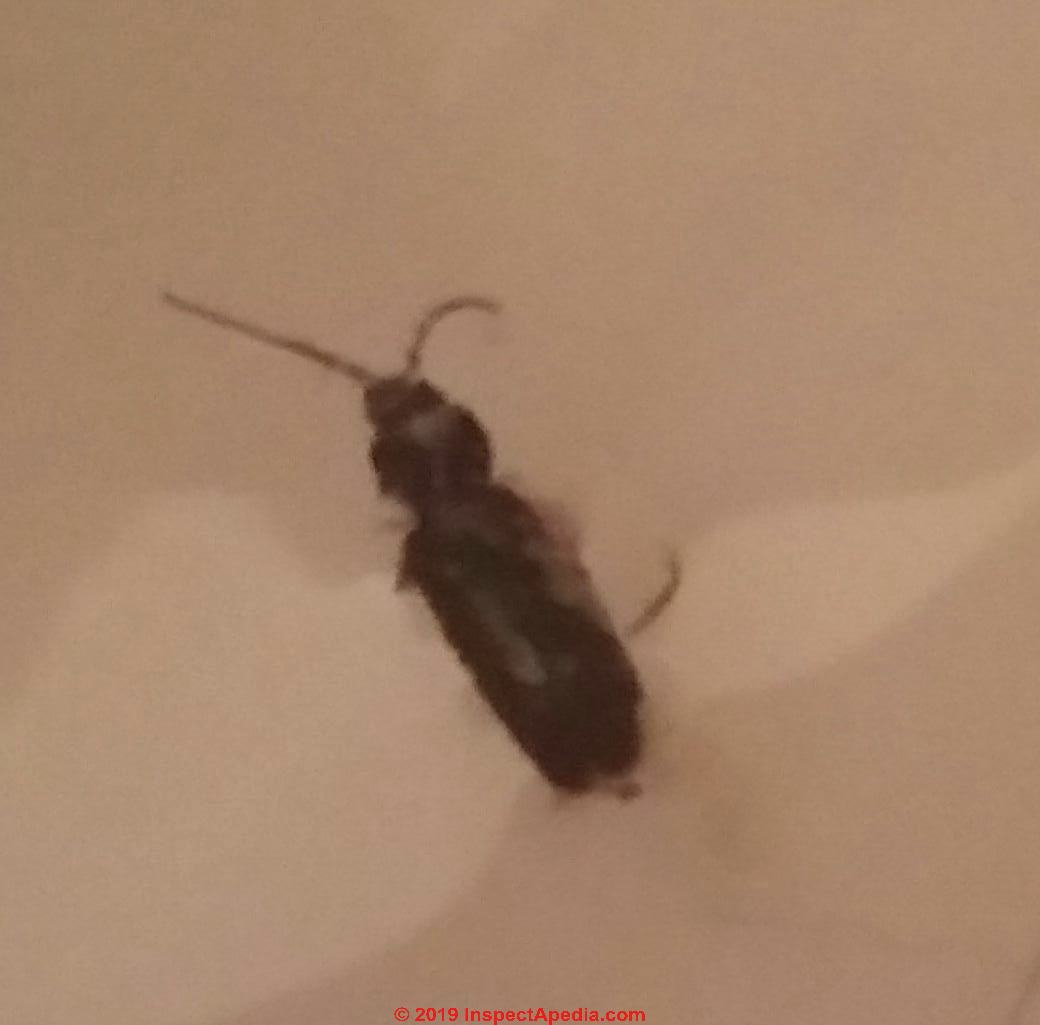 2020/03/06 crystalgrant39 said:
2020/03/06 crystalgrant39 said:
I made a bed out of blue pine sanded and varathane the wood. It has been in the home about two months.
In the last month beetles have come out of the wood. I estimate we have found abut 15 beetles in 1 month.
Do I have to get rid of the bed? Will the beetles eat my house? I appreciate your thoughts. I tried to include a picture of 1 of the beetles.
Reply:
Crystal:
Your photo is of a Lyctid powder post beetle - good going. If you can take a sharper image I'd sure like to include it in the article above.
About your bed:
It sure sounds as if that pine is infested.It is very hard to completely kill all of the powderpost beetle larvae and beetles in infected wood. That's why standard advice is to "remove all of the infested wood completely"
But let's not give up right away.
You might be able to salvage it by aggressive insecticide treatment.
To do this effectively you'll need to strip all of the wood surfaces of any paint or varnish or sealer (otherwise the insecticide isn't effective). Experts point out that surface treatment ONLY kills the adult beetles as they emerge, it doesn't kill the larvae deep in the wood. (That's why treating powder post beetles is so difficult).
More help and advice and treatment and prevention suggestions for wood destroying beetles is are given above on this page.
I would remove the bedding, dis-assemble the bed as far as possible, then take it outside or out of the living area (such as into a garage) where it can be treated with insecticide and left in sealed plastic covering or bags for a month or two.
Or alternatively, if it is possibe for you to heat the wood without damaging it, (less than 2" thick) to a sufficient temperature (wood internal temperature must reach 140-150 F for 2-4 hours) you may be able to kill the larvae.
Wipe the wood clean, treat it, bag it, wait, then inspect it for sawdust or other indications of insect activity.
Keep me posted.
...
Continue reading at COMPARE TERMITE DAMAGE to POWDER POST BEETLE or select a topic from the closely-related articles below, or see the complete ARTICLE INDEX.
Or see POWDER POST BEETLE DAMAGE FAQs - questions & answers about finding & evaluating old house borer or powder post beetle damage posted originally at the end of this page.
Or see these
Recommended Articles
- COMPARE TERMITE DAMAGE to POWDER POST BEETLE
- INSECT INFESTATION / DAMAGE - home
- INSECT DAMAGE PREVENTION
- MERULIPORIA FUNGUS DAMAGE
- MOTHS, MOTHBALL ODORS - control, hazards
- POWDER POST BEETLES
- STRUCTURAL DAMAGE PROBING
- TERMITE DAMAGE PROBING
- WOOD STRUCTURE ASSESSMENT - home
Suggested citation for this web page
POWDER POST BEETLES at InspectApedia.com - online encyclopedia of building & environmental inspection, testing, diagnosis, repair, & problem prevention advice.
Or see this
INDEX to RELATED ARTICLES: ARTICLE INDEX to INSECT DAMAGE
Or use the SEARCH BOX found below to Ask a Question or Search InspectApedia
Ask a Question or Search InspectApedia
Try the search box just below, or if you prefer, post a question or comment in the Comments box below and we will respond promptly.
Search the InspectApedia website
Note: appearance of your Comment below may be delayed: if your comment contains an image, photograph, web link, or text that looks to the software as if it might be a web link, your posting will appear after it has been approved by a moderator. Apologies for the delay.
Only one image can be added per comment but you can post as many comments, and therefore images, as you like.
You will not receive a notification when a response to your question has been posted.
Please bookmark this page to make it easy for you to check back for our response.
IF above you see "Comment Form is loading comments..." then COMMENT BOX - countable.ca / bawkbox.com IS NOT WORKING.
In any case you are welcome to send an email directly to us at InspectApedia.com at editor@inspectApedia.com
We'll reply to you directly. Please help us help you by noting, in your email, the URL of the InspectApedia page where you wanted to comment.
Citations & References
In addition to any citations in the article above, a full list is available on request.
- [1] Paul Probett, Clinton Craig, Blake Probett, "An Introduction to Micro-Drilling Technology for N. Z. Structural Timber Assessment", Incodo Ltd, 4/511 Cameron Rd, Tauranga NZ, article adapted by InspectAPedia with permission, August 2012. Contact the authors by Email: Paul Probett, mail2us@incodo.co.nz , Tel: 027 28 000 36 (Mobile) Website: https://www.incodo.co.nz/ [Copy of this article on file as Microdrilling_Assessment_Incodo.pdf]
Quoting from the Incodo website the company describes its services:
- Incodo Forensic Building Pathology:
The Forensic Building Pathology division provides evidence in report form to government agencies, consultancy firms, lawyers and others, when truly independent analysis based on comprehensive testing is required. Incodo arguably has the largest, most up-to-date and comprehensive range of building investigation equipment available and has developed unique methodologies particularly in the field of non-destructive testing for leaking structures. - Incodo Insitu Timber Assessment:
The in-situ Timber Assessment division provides a service whereby technicians use state-of-the-art timber resistance drill technology to profile variations in timber density associated with timber decay.
The work is done on site and the results are instant.
This technology is objective and evidential in nature and provides assessment as to whether wood is significantly decayed, suspect or suitable for retention. The technology has particular application in locating and assessing hidden decay.
- Incodo Forensic Building Pathology:
- [2] Thomas Tannert, Andreas Muller, Mareike Vogel, "Applications and limitations of NDT: a timber bridge case study", NDTCE’09, Non-Destructive Testing in Civil Engineering
Nantes, France, June 30th – July 3rd, 2009, web search 8/3/2012, original source: http://www.ndt.net/article/ndtce2009/papers/144.pdf [copy on file as Tannert_Timber_Test_144.pdf]
Abstract
The applications and limitations of different non-destructive and semi-destructive techniques to evaluate the structural integrity of timber members in a pedestrian bridge are presented as a case study.
Sophisticated assessment tools are required to detect hidden damages in timber structures: for example stress-wave techniques are used to evaluate the modulus of elasticity of bending members and resistance to drilling is used to gain knowledge of areas of changed density due to insect or moisture induced damages.
Reliably relating the gathered data to the structural integrity of the structure is a complex issue. Bending members and connection details of a decommissioned timber bridge were evaluated using non destructive assessment tools. Eventually these parts were tested destructively to assess their remaining modulus of elasticity and load bearing capacity.
The need for improvements in the current practice is highlighted by comparing the results from the non-destructive, semidestructive and destructive tests. - [3] Bohumil Kasal, Thomas Tannert, "RILEM Technical Committee on In Situ Assessment of Structural Timber", Bohumil Kasal et al., 2010, Advanced Materials Research, 133-134, 271,
Abstract:
Timber is an intriguing structural material and the only one that is truly renewable. Being biodegradable, hygroscopic and non-isotropic, it presents special challenges when assessing its integrity in structures. The presented paper outlines the major issues related to in-situ evaluation of structural timber and summarizes the work of the RILEM Technical Committee 215-AST “In-situ assessment of structural timber”.
The committee was established in 2005 to bring together leading scientists and practitioners in the field of evaluation of timber in existing structures. Timber structures have been investigated for decades using numerous techniques that have been either developed specifically for the material or were transferred from other fields of investigation.
A state-of-the-art report describing existing and emerging technologies and methods was prepared by the RILEM committee.
The report describes the principles, the applications and the limitations of major evaluation techniques for in-situ assessment of timber. A brief discussion of codes standards and future research needs shows that much needs to be done in this area.
As a present activity, harmonized test procedure recommendations are being prepared that will provide the engineering community with valuable guidance when evaluating timber structures. - [4] Bohumil Kasal & Thomas Tannert (Editors), In Situ Assessment of Structural Timber, ISBN 978-94-007-0559-3, Rilem 2010
- [5] Bohumil Kasal, Tension Micro Specimens,
In Situ Assessment of Structural Timber
RILEM State of the Art Reports, 2011, Volume 7, 75-80, DOI: 10.1007/978-94-007-0560-9_8, [excepts chapter 7 on file: Tension Micro-Specimens, as Kasal_Testing.pdf]
Abstract
The principle of this method is extracting triangular specimens (about 5 mm equal-sides triangle) along the length of the member. Small-kerf circular saw with a fixture attached to the surface of the member is used to extract the specimens. Specimens are then glued to the test blocks and tested in tension. The method gives direct values of tensile modulus of elasticity and strength for clear wood. The values are local and pertain to the tested area and surface.
[From chapter 7.1 Background:
This method was developed by Kasal and is based on direct measurement of tension properties along fibers. Bending strength evaluation is an important aspect of in situ evaluation of timber members as it is one of the predominant modes of loading, but estimates of the bending properties in situ can present a challenge.
With information on the member's tensile properties, bending strength estimates can be made; tensile strength has been related to bending strength and is considered to be approximately equal.
Tensile properties have a poor correlation with compression properties therefore tensile strength can not be estimated using information attained with the core drilling technique. Specimens can however be extracted to evaluate the tensile properties of in situ members with the technique described in the following sections....'] - [Also] Kasal B, Anthony R: Advances in in-situ evaluation of timber structures. Progress in Structural Eng and Materials. 6(2):94-103, 2004.
- [6] Thomas Tannert, Andreas Müller, Mareike Vogel, "in-situ assessment, hot spots, moisture content, block-laminated timber", ICTB 2010, Bern University of Applied Sciences. ISBN 978 8251 926805, in-situ assessment, hot spots, moisture content, block laminated timber,
Abstract:
Timber has been a structural material for bridges for centuries and numerous examples throughout the world demonstrate its durability. But timber is biodegradable and hygroscopic and regular inspections are recommended to determine the condition of the structure.
This paper reports on the structural health monitoring of timber bridges in general and the long term moisture measurement inside block-laminated timber elements of several traffic bridges in specific. Presently there is no reported scientific information available on the long-term moisture behaviour and the resulting moisture induced stresses and dimensional changes of block-laminated timber elements.
The paper reports on the monitoring of the moisture content of a block-laminated timber bridge.
[References 7-13 below are cited from this document] - [7] Wilkinson K, Thambiratnam D, Ferreira L. Non Destructive Testing of Timber Bridge Girders. In Proceedings Int. Conf. on Structural Condition Assessment, Monitoring and Improvement, Perth, Australia, 2005.
- [8] Kasal B, Anthony R: Advances in in-situ evaluation of timber structures. Progress in Structural Eng and Materials. 6(2):94-103, 2004.
- [9] Gerold M. Bloc-Glued Laminated decks for timber bridges. Structural engineering international, 12(3): 214–217, 2002.
- [10] Graham T. Overview of non-destructive evaluation technologies. In Proceedings of the Nondestructive Evaluation of Aging Bridges and Highways, Ed by S. Chose, 1995.
- [11] Duwadi SR, Ritter MA. An Overview of the Wood in Transportation Program in the United States, In Proceedings 5th World Conference on Timber Engineering, Montreux, Switzerland, 1998.
- [12] Rinn F, Schweingruber FH, Schär E. Resistograph and X-Ray Density Charts of Wood. Comparative Evaluation of Drill resistance Profiles and X-Ray Density Charts of Different Wood Species. Holzforschung 50:303-311, 1996.
- [13] Brashaw B, Vatalaro RJ, Wacker JP and RJ Ross. Condition Assessment of Timber Bridges: 1. Evaluation of a Micro-Drilling Tool. Gen. Tech. Rep. FPL-GTR-159. Forest Products Laboratory Madison, WI. 2005.
- [14 Simpson W. Drying and Control of Moisture Content and Dimensional Changes. Chapter 12, Wood handbook - wood as an engineering material. General Technical Report FPL–GTR– 113. Forest Products Laboratory, WI, 1999.
- [15] "Fractometer Print Manual", IML Instrumenta Mechanik Labor System GmbH Großer Stadtacker 2 69168 Wiesloch • Germany, 02-2008, web search 8/4/12, original source: http://www.imlusa.com/Fractometer_Print_eng_web_A4.pdf [Copy on file as Fractometer_Print_eng.pdf]
- [16] Bob Monk, "Evaluation of Decay Detection Equipment in Standing Trees", USDA Forest Service, web search 8/4/12, original source http://www.fs.fed.us/eng/techdev/IM/tree_decay/tree_decay_detect_equip.shtml [Copy on file as Monk_Tree_Deday_Detection.pdf] Introduction - quoting:
A project was proposed to test and compare several of the devices that are able, to some degree, to detect decay in trees. Decay in trees is directly related to the hazards that they present. However, detection of decay does not necessarily mean that a tree is hazardous.
The identified devices can be used to determine what decay is present. It is still necessary to use professional experience and sound judgment to decide if a tree actually poses a hazard. General guides or "rules of thumb" can also be used, such as Guidance notes from the Minnesota Department of Natural Resources and the USDA Forest Service, 1996 that suggests a 25 mm ring of sound wood is required for every 150 mm of stem diameter at any point on the stem.
If the proportion of decayed wood to sound wood exceeds this level then action may need to be taken to minimize the hazard posed by the tree (Lawday and Hodges, 2000). [Additional selected citations from this article are below]- [16a] Larsson, B.; Bengtsson, B.; and Gustafsson, M. 2004. Nondestructive Detection of Decay in Living Trees. Tree Physiology. 24: 853-858
- [16b] Moore, W. 1999. The Combined Use of the Resistograph and the Shigometer for the Accurate Mapping and Diagnosis of the Internal Condition of woody Support Organs of Trees. Arboriculture Journal. 23: 273-287
- [16c] Nicolotti, G.; Socco, L.V.; Martinis, R.; Godio, A.; and Sambuelli, L. 2003. Application and Comparison of Three Tomographic Techniques for Detection of Decay in Trees. Journal of Arboriculture. 29(2): 66-77
- [16d] Seavey, R.; and Larson, T. 2002. Inspection of Timber Bridges. Minnesota Department of Transportation Technical Report MN/RC-2002-34. St. Paul, MN. 43 p.
- [16e] Wang, X.; Divos, F.; Pilon, C.; Brashaw, B.K.; Ross, R.J.; and Pellerin, R.F. 2004. Assessment of Decay in Standing Timber Using Stress Wave Timing Nondestructive Evaluation Tools: A Guide for Use and Interpretation. Gen. Tech. Rep. FPL-GTR-147. Madison, WI: U.S. Department of Agriculture, Forest Service, Forest Products Laboratory. 11 p.
- [17] Pilodyn Wood Tester, USA / Canadian Source: Intech-NDE, 6211 Roper Road
Edmonton, Alberta
T6B 3G6, Tel: 1 888-576-7756 or Intech-NDE, 140 - 8851 Beckwith Road
Richmond, B.C., Tel: 1 800-677-8884, or USA Tel: 800-297-3208, Website: http://www.intechnde.com, web search 8/4/12, original source: http://www.corvib.com/pilodyn/ Quoting:
Pilodyn is an easy-to-use wood testing instrument which is suitable for trees, railway ties and utility poles. The Pilodyn wood tester (Hylec Controls) is described by and
currently available in North America from InTech/NDE U.S. Tel: 905-716-5604 / 800-297-3208, or Email: bnadeau@intechnde.com - [18] Pilodyn Wood Tester, Hylec Controls, available in Australia from Ferret http://www.ferret.com.au/n/Pilodyn-wood-density-meter-from-Hylec-n852069 - Quoting:
Pilodyn, available from Hylec Controls , was developed to determine the density and strength of dead and living wood. Invisible soft rot can be detected rapidly and objectively in an easy non-destructiveway and the reduction in strength associated with it can be determined.
This can be of vital importance in the case of wooden playground structures,climbing frames and telephone masts.
With PILODYN 6J Forestversion the density of the wood is determined on living trees. The damage is so little that the tree suffers no harm and the testing method is regarded as non-destructive.
Testing procedure: The testing procedure is very simple: The tester is loaded with the ramrod and then pressed firmly onto the tet surface. The impact pin is shot into the wood by pressing the trigger cover. The depth of penetrationcan be read straightaway in mm on the scale mounted on the tester.
Typical applications of the Pilodon:
Testing the stability of wooden structures on playgrounds, detection of soft rot
Testing the strength on wooden telephone masts, detection of soft rot
When thinning out: sorting out trees with undesirable density of the wood
Early detection of diseases: periodic measurement detects unnatural changes in the wood density
Comparison of the location-dependent density to determine the optimal location for the respective tree species
Establishing productivity with respect to density for the same tree species and similar location properties for culture purposes Testing and sorting of cut wood into timber classes - [19] Hylec Controls, 8 Melissa Street AUBURN NSW 2144 AUSTRALIA, Tel: 1300 522 004, Email: sales@hyleccontrols.com.au, http://www.ferret.com.au/c/Hylec-Controls
- [20] Brashaw, Brian K.; Vatalaro, Robert J.; Wacker, James P.; Ross, Robert J. 2005. "Condition Assessment of Timber Bridges: 1. Evaluation of a Micro-Drilling Resistance Tool" Gen. Tech. Rep. FPL-GTR-159. Madison, WI: U.S. Department of Agriculture, Forest Service, Forest Products Laboratory. 8 p., web search 8/5/2012, original source: http://www.fpl.fs.fed.us/documnts/fplgtr/fpl_gtr159.pdf [copy on file as Micro_Drill_Study_USDA_fpl_gtr159.pdf] This publication is also available from the U.S. FPL at www.fpl.fs.fed.us
Abstract:
The research presented in this report was conducted to evaluate the accuracy and reliability of a commercially available micro-drilling resistance device, the IML RESI F300-S (Instrument Mechanic Labor, Inc., Kennesaw, Georgia), in locating deteriorated areas in timber bridge members.
The device records drilling resistance as a function of drilling depth, which allows the operator to assess the location of deterioration in the member cross section. Bridge components containing different levels of natural decay were used as test specimens in this study.
The IML RESI F300-S was first used to assess decay in the timber bridge specimens. The specimens were then sawn along their length into slabs to expose their interior condition.
The interior faces of these slabs were inspected visually and with a stress-wave probe to confirm if deterioration was present. On the basis of these tests, we conclude that this micro-drilling device accurately determines if deterioration is present at the point at which the test is performed. Keywords: timber, bridges, inspection, drilling resistance, nondestructive evaluation
Excerpt from the study's conclusions:
|
Based on our tests, we offer the following comments about the accuracy of using the IML RESI F300-S for locating deterioration in bridge timbers:
1. The tool is accurate at determining the presence of decay in timber bridge specimens. However, these data are limited to the drilling location.
2. The tool can precisely locate an internal defect (decay pocket, check, or split) within the member’s cross section. This can be advantageous for condition assessment and load rating purposes.
3. Decay indices were developed for Douglas-fir timbers as follows: sound, >25% resistance; moderate decay, 10–25%; and advanced or severe decay, 0–10%.
One drawback is that multiple, time-consuming drilling would be required to map the area and extent of the decay in the other plane. Another possible drawback is the potential to spread the decay to sound areas within a timber or to sound timbers by multiple use of a contaminated drill bit. Routine cleaning of drill bits, or replacement with a new one, would greatly reduce this potential drawback.
It is crucial to use this or any nondestructive testing tool or device as part of a comprehensive condition assessment. Such an assessment should incorporate an in-depth visual inspection, knowledge of prior use of the structure, and a working knowledge of fundamental engineering properties of structural wood products.
This technique, when used in concert with visual and ultrasound techniques, would provide a very accurate description of the condition of timbers. - [21] Brashaw, B.K.; Vatalaro, R.J.; Erickson, J.R.; Forsman, J.W.; Ross, R.J. 2004. Final Report: A Study of Technologies to Locate Decayed Timber Bridge Members. Project No. 187-6456, NRRI/TR-2004-06. Duluth, MN: UM-Duluth, Natural Resources Research Institute.
- [22] Brashaw, B.K.; Vatalaro, R.J.; Ross, R.J.; Wacker, J.P. 2005. Condition Assessment of Timber Bridges: 2. Evaluation of Several Commercially Available Stress Wave/Ultrasonic Tools. Gen. Tech. Rep. FPL-GTR-160. Madison, WI: USDA Forest Service, Forest Products Laboratory.
- [23] Ross, R.J.; Brashaw, B.K.; Wang, X.; White, R.H.; Pellerin, R.F. 2004. Wood and Timber Condition Assessment Manual Madison, WI: Forest Products Society. 74 p.
- [24] Troltech GMBH & Co. KG. Deutchland, Grebbener Str. 7, D-52525 Heinsberg, Deutchland, produces the Trotec T2000, Tel: 02452 962-450, International: +49 2452 962-450, Email: online@trotec.de, Website: http://www.trotec.de/, Web page for the Troltec T2000: http://www.trotec.de/en/product-catalog/measuring-instruments/multi-function/t2000/
- [25] Paul Probett, Incodo, Ltd., "Thermal Imaging and Building Surveying / Inspection" 2008, Incodo Ltd, 4/511 Cameron Rd, Tauranga NZ, article adapted by InspectAPedia with permission, August 2012. Contact the authors by Email: Paul Probett, mail2us@incodo.co.nz , Tel: 027 28 000 36 (Mobile) Website: https://www.incodo.co.nz/ [Copy of this article on file as Thermal Imaging NDT Presentation 2008.ppt ]
- Design of Wood Structures - ASD, Donald E. Breyer, Kenneth Fridley, Kelly Cobeen, David Pollock, McGraw Hill, 2003, ISBN-10: 0071379320, ISBN-13: 978-0071379328
- Diagnosing & Repairing House Structure Problems, Edgar O. Seaquist, McGraw Hill, 1980 ISBN 0-07-056013-7 . Ed Seaquist was among the first speakers invited to a series of educational conferences organized by D Friedman for ASHI, the American Society of Home Inspectors, where the topic of inspecting the in-service condition of building structures was first addressed.
- Truly Nolen Pest Control, Tel: 866-221-4765, is a national franchise of pest control operators in the U.S. Quoting from the company's website:
Truly Nolen [has] over 80 offices located in Arizona, California, Florida, Nevada, New Mexico, Texas and Utah. The company services more than 150,000 customers and employs about 1,100 partners, with almost 50 percent service technicians. - U.S. EPA. Prevention, Pesticides, and Toxic Substances. 1997. Re registration eligibility decision: Diflubenzuron. Pp. 17, 46. www.epa.gov/ pesticides.
- U.S. EPA. Office of Prevention, Pesticides and Toxic Substances. 1994. Pesticide fact sheet: Hexaflumuron. Washington, D.C.
- U.S. EPA. Office of Pesticide Programs. 2003.
Pesticide ecotoxicity database. Unpublished database.
U.S. EPA. Prevention, Pesticides, and Toxic Substances. 1998. Re registration eligibility decision: Hydramethylnon. Pp. 16-18, 43. www.epa.gov/pesticides. - U.S. EPA. Prevention, Pesticides and Toxic Substances. Undated. New chemical New chemical fact sheet: Noviflumuron. Washington, D.C.
- Pesticides Contaminate House [PDF] - news article about improperly applied pesticide chemicals and building contamination
- In addition to citations & references found in this article, see the research citations given at the end of the related articles found at our suggested
CONTINUE READING or RECOMMENDED ARTICLES.
- Carson, Dunlop & Associates Ltd., 120 Carlton Street Suite 407, Toronto ON M5A 4K2. Tel: (416) 964-9415 1-800-268-7070 Email: info@carsondunlop.com. Alan Carson is a past president of ASHI, the American Society of Home Inspectors.
Thanks to Alan Carson and Bob Dunlop, for permission for InspectAPedia to use text excerpts from The HOME REFERENCE BOOK - the Encyclopedia of Homes and to use illustrations from The ILLUSTRATED HOME .
Carson Dunlop Associates provides extensive home inspection education and report writing material. In gratitude we provide links to tsome Carson Dunlop Associates products and services.


